Gangotri National Park is the largest protected area in Uttarakhand located in Uttarkashi district, covering around 2,390 km². Located in the upper catchment area of Bhagirathi, it is home to the source of the Ganga River and Gangotri Glacier.1 The park hosts diverse Himalayan vegetation, wildlife, and alpine meadows, which attract nature lovers, trekkers, pilgrims, and adventure enthusiasts alike. The divine aura of Gangotri Dham, beautiful waterfalls, and densely covered forest canopies make it a perfect holiday destination.
This detailed guide will give you a virtual walkthrough of the beautiful ecosystem of the Gangotri National Park, highlighting its biodiversity and ecology.
Table of Contents
About Gangotri National Park: When and Where
History
The sacred town of Gangotri has been an important site for the Ganga devotees since medieval times. The Ganga temple’s popularity increased during the nineteenth century, the region witnessed developments in the infrastructure. With the growing number of tourists and pilgrims visiting the Gangotri Dham every year, the pristine region started getting polluted. Additionally, the adverse impact of human activities and global warming resulted in the slight withdrawal of the Gangotri Glacier.

The need to protect the eco-sensitive area of Gangotri to control the ill effects of tourism became increasingly urgent. Under the Wild Life Protection Act, the central government established Gangotri National Park in 1982, to conserve its rich biodiversity and the surrounding ecosystem.
Geography
The Gangotri National Park is spread across the Garhwal Himalayas at an altitude ranging from 1,800 m to 7,083 m (Satopanth Peak).2 Its topography features high ridges, deep gorges, rocky cliffs and glaciers, and narrow valleys. The park is situated strategically along the Indo-Tibet international borders towards its northeast. The vast expanse of its area interlinks the Govind National Park and Kedarnath Wildlife Sanctuary.3 This is the largest national park in Uttarakhand.
The climate in Gangotri National Park varies significantly with altitude. The lower regions experience a Western Himalayan Subalpine climate, while the higher altitudes receive cold and harsh weather conditions.

Best Time to Visit (May to October)
The best time to visit Gangotri National Park is from May to October. The Park remains closed in winter from 15th November and opens in May. The experience varies significantly with each season:
Spring and Summer (May to June)
The temperature in spring and summer varies from 10°C to 23°C during the day, while nights remain cool at around 10°C to 5°C. In spring, the weather warms up, the park transforms into a vibrant landscape swarming with life. The days are sunny, providing a perfect opportunity for exploring the nature and beauty of the park. Spring and Summer are ideal for trekking, with trails becoming more accessible as the snow melts. Popular treks include the Gaumukh trek, which leads to the source of the Ganga River.
Monsoon (July to September 1st week)
The monsoon season in Gangotri National Park brings heavy rainfall, transforming the landscape into moss-covered scenery. Temperatures during the monsoon season range from 10°C to 20°C.
Monsoons witness fewer tourists due to the possibility of landslides and floods, and busy routes to Gangotri due to the Kanwar Yatra. This season is ideal if you wish to explore the park’s natural beauty without the hustle and bustle of crowds. The waterfalls are brimming, and the flora is vibrant and lush. It offers a unique experience for the bold at heart. However, trekking is not advisable due to slippery muddy trails and the risk of landslides.
Autumn (September to October)
Temperatures during autumn can drop significantly, ranging from -10°C to 15°C. The nights are nippy, often plunging below freezing. November marks the onset of winter, and by December, snow becomes a common sight.
October is ideal for photography enthusiasts, as the stark contrasts between the golden hues of the forest and pink sunsets create breathtaking views. Additionally, the calm atmosphere provides an opportunity for meditation and spiritual reflection. The gates of the Gangotri Dham close after the Diwali festival, and the footfall for Gangotri National Park also decreases.

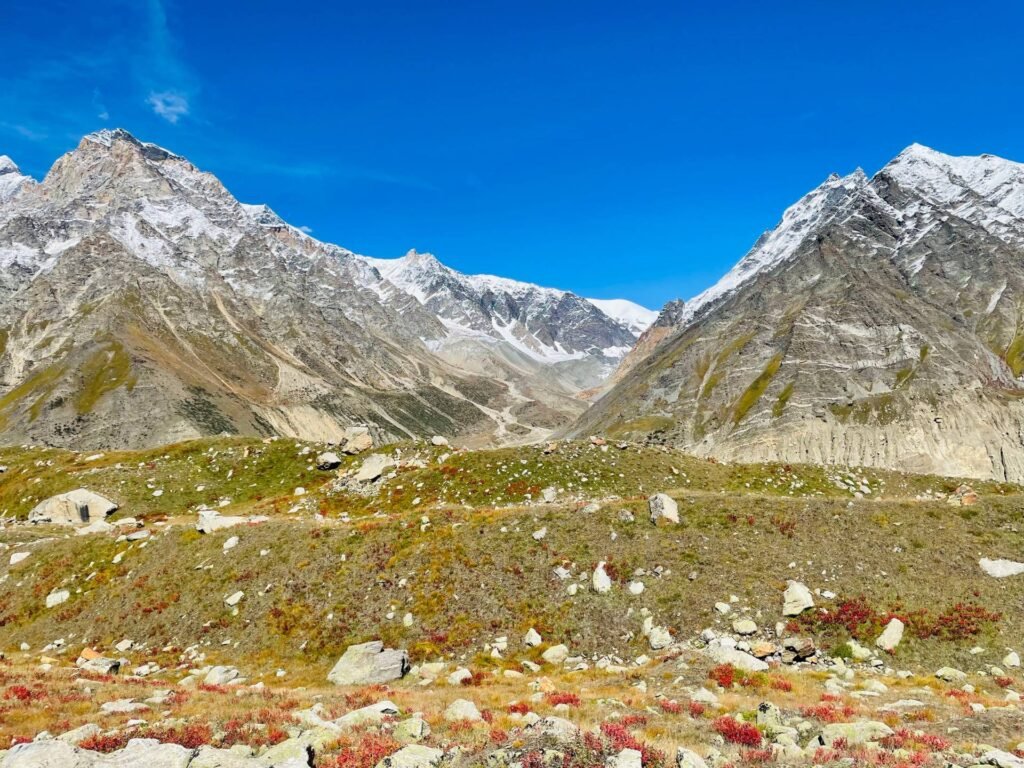
Permits and registrations
Entry to the Gangotri National Park requires a special permit because a limited number of tourists are allowed inside the protected area, at a time. The cost for the pass is INR 250-300, it can be obtained by:
- Online Mode– you can use the SWS (Single Window System), Uttarakhand to register for the permit.
- Offline Mode– District Forest Officer (DFO) Uttarkashi or DFO Gangotri grants the permit to enter the Park. Carry your Aadhar card and PAN card, to apply and register.
The Forest Check Post, about 1.5 km from Gangotri is designated to check the appropriate tourist permit for entering the national park.
Flora and Fauna: The Biodiversity of Gangotri National Park
Gangotri National Park is a biodiversity hotspot, home to a range of flora and fauna. The fertile Bhagirathi basin makes an ideal habitat that supports wildlife and forests:
Flora at GNP
The basin has a thick forest cover, and the vegetation varies from Himalayan Moist Temperate Forests to the Alpine scrub and pastures. The lower altitudes of the park consist of Chir Pine, Deodar, Banjh Oak, Spruce, and Rhododendrons. This part supports human activities with the patches of agricultural fields. Moru Oak dominates the middle altitudes. The higher altitude consists of the dense forests of Betula, Kharsu oak and alpine vegetation.4
If you visit the Gangotri National Park during the summer and spring seasons, you can see colorful wildflowers blanketing the trails. Here are some of the trees, medicinal herbs, and flowering shrubs found in the area:
- Blue Pine or Pinus wallichiana
- Chinar or Poplar
- Chappar-tang or Himalayan Woodbine
- Bhootkeshi or Selinum Tenuifolium
- Atish or Aconitum heterophyllum
- Salam Panja/Hath-Panja or Dactylorhiza hatagirea
- Kutki or Picrorhiza kurroa
- Dhup or Jurinea dolomiaea
- Red-Stem Barberry or Berberis Jaeschkeana
- Lichholi or Fringed Spindle Tree
- Baakhre Jhaar or Himalayan Sorbaria
- Himalayan Honeysuckle
- Kaliso or Himalayan Holly
- Angeri or Oval-Leaf Lyonia
Fun Fact: This rich floral value of the Park has names of many places based on them such as Chirbasa ( Pinus wallichiiana, locally called Chir) and Bhojbasa ( Betula, locally called Bhoj).
Fauna and Avifauna at GNP
The fauna of the National Park of Gangotri is equally diverse, with 15 species of mammals and 150 species of birds inhabiting the area.
The protected area of Gangotri is host to threatened and endangered wildlife species like:
- Snow Leopard
- Black Bear
- Brown Bear
- Musk Deer
- Blue sheep or Bharal
- Himalayan Musk Deer
- Himalayan Tahr
- Red Fox
- Himalayan Yellow-throated Marten
- Himalayan Weasel
Fun Fact: Gangotri National Park is said to be the only protected area where Bharals are habituated to people.

The commonly spotted avifauna species in the National Park are:
- Common Hill Partridge
- Kaleej Pheasant
- Koklass Pheasant
- Monal Pheasant
- Himalayan Snowcock
- Cheer Pheasant
- Himalayan griffon
- Yellow-billed blue magpie
Apart from these, the national park has a variety of reptiles like the Himalayan pit viper
Kukri snake, Common Krait, Indian cobra, and butterflies like Hesperiidae, Papilionidae, Pieridae, Lycaenidae and Nymphalidae, grace the forest.5
Trekking and Adventure Opportunities in Gangotri National Park
For adventure enthusiasts, Gangotri National Park offers many trekking opportunities that cater to various skill levels, these are:
Gaumukh-Tapovan Trek
The Gangotri-Gaumukh-Tapovan trek is one of the most iconic treks in the region, attracting trekkers and pilgrims alike. You can start this trek from Gangotri (3,042m), hike through Gaumukh (4,023m), and finally reach Tapovan (4,463m).
The total distance is around 45-46 km and takes 8-9 days to complete. Difficulty level is moderate to challenging, you need to be physically fit to complete it. The beautiful views of Mt Shivling and the Bhagirathi sisters, make it one of the best trekking destinations in Uttarakhand.

Kedartal Trek
Kedartal, or the ‘Lake of Shiva,’ is an alpine glacial lake fed by the melting snow of Thalaysagar and Brighupanth Peak. It takes you through stunning views of other lofty peaks like Mt Shivling, Manda, Bhagirathi, Gangotri, and Mt. Meru.
The base starts from Gangotri and ends at Kedartal (4750m). The 48 km to and fro trek requires around 6-7 days. The Kedartal trek is challenging and requires prior trekking experience due to its steep trails and high altitude.

Patangnidhar Trek
The trek to Patangnidhar Pass starts from the Gangotri and passes through Bhojkharak, Kedarkharak, Kedartal, and finally, steep upward ascend from Patangnidhar base camp. This trek offers a bird-eye view of the Gangotri National Park and Kedar Tal.
The to-and-fro distance of the trekking route is around 60 km, which may take around 8-10 days to complete. The Patangnidhar is a challenging trek suitable for seasoned trekkers.
Nandanvan Vasuki Tal Trek
The Nandanvan Vasuki Tal Trek is an offbeat trek that leads you into the heart of the Gangotri National Park. The lovely sights of the Gangotri Glacier, the Bhagirathi peaks, the high-altitude glacial lake Vasuki Tal and lush green meadows of Nandanvan, provide a landscape of rugged mountains covered with Himalayan flowers and herbs.
The total distance of the Nandavan trek is 65 km to and fro from Gangotri, which takes 9-10 days. This is a moderate trek that requires ample experience and reasonable fitness to complete.
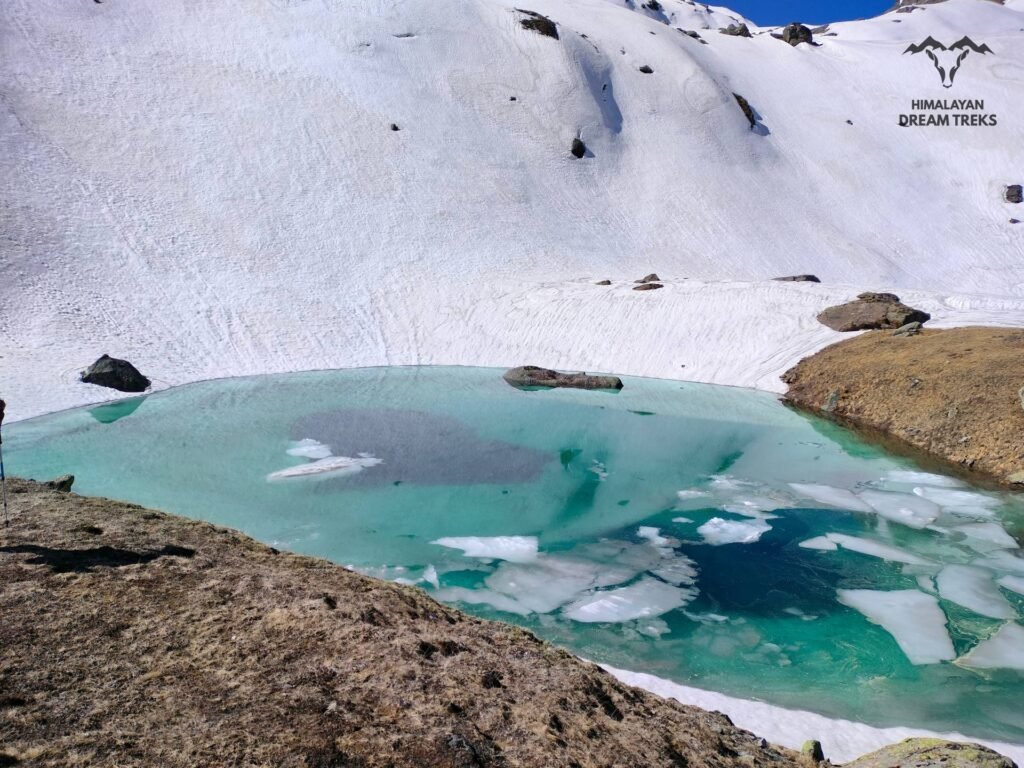
Janaktal Trek
The trek to Janaktal, the source of Jad Ganga starts from the Jadung Village near the Nellong Valley. It offers less-explored trails in the Gangotri National Park, giving a peek into the exotic species of the protected area. If you are an astronomy enthusiast, then Janaktal’s clear night skies are ideal for a beautiful view of stars and constellations.6
The trek to Janaktal is approximately 22 km to and fro, which takes 3-4 days to complete from Nelong. It is a moderate to challenging trek suitable for seasoned trekkers. A Special Inner Line Permit is needed to do this trek.
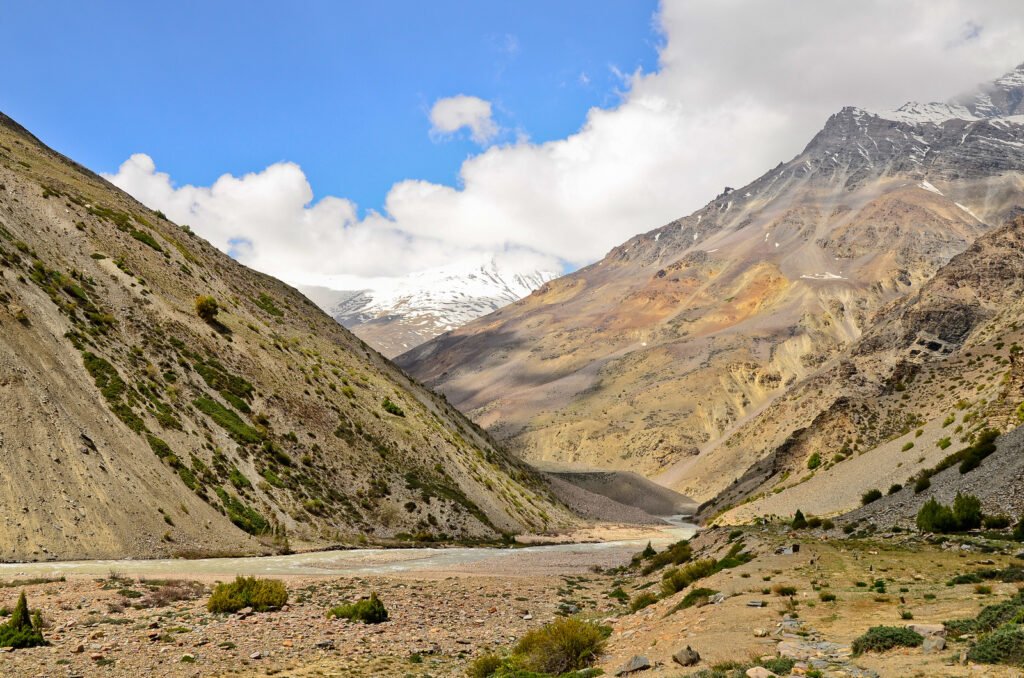
Kalindi Khal Trek
The Kalindi pass of the Kalindi Peak is one of the world’s highest trekkable mountain passes. The Kalindi Khal trek offers stunning views of prominent mountain peaks and glacial streams in the Gangotri National Park. It features Chaturangi Glacier and glacial lakes like Vasuki Tal at 4,800 meters and Arwa Tal at 3,910 meters.
It is one of the toughest treks and requires prior experience in high-altitude trekking. It starts from the Bhagirathi valley, passing through Gaumukh, Tapovan, Nandantal, Suralya Bamak, and Kalindi base. From here, the trail goes upwards to the Kalindi summit, the downward trail passes through Arwa Tal, Mana village via Ghastoli, and the trekkers hike to Badrinath. This entire trek connects two pilgrimage sites of Gangotri and Badrinath which takes about 14 days.
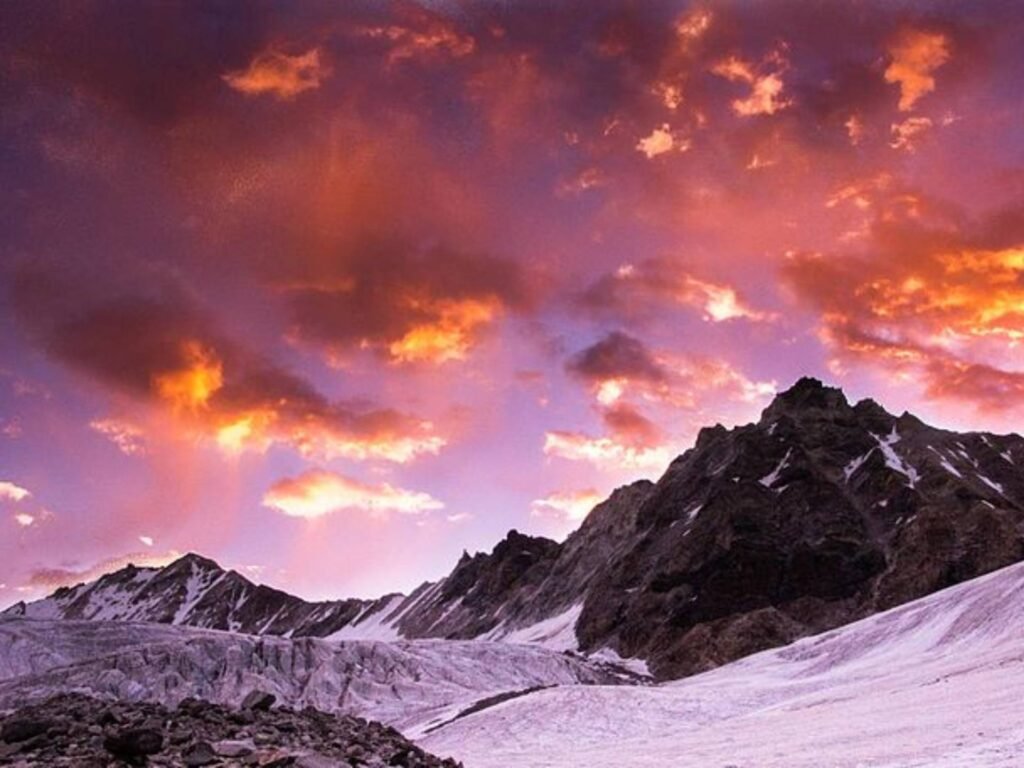
Auden’s Col Summit trek
Auden’s Col was discovered in 1935 by John Bicknell Auden of the Geological Survey of India. The trek features stunning landscapes with prominent peaks of Gangotri group, Bhagirathi group, Rudragaira, Jogin group and Kedar Dome.
Auden’s Col is located at an elevation of about 5489 m, the trek to its summit starts from the Gangotri. It is approximately 95 km from Gangotri to Kedarnath and requires 15-16 days to complete. The trek to Auden’s Col is challenging with dangerous ridges and narrow trails. This trek is considered the one of the most difficult treks in India. It is suitable for experienced trekkers who are familiar with adverse trekking conditions. This corridor serves as a connection between Gangotri and Kedarnath. Before John Bicknell Auden’s visit, it was regarded for centuries by devotees as an ancient pilgrimage route.
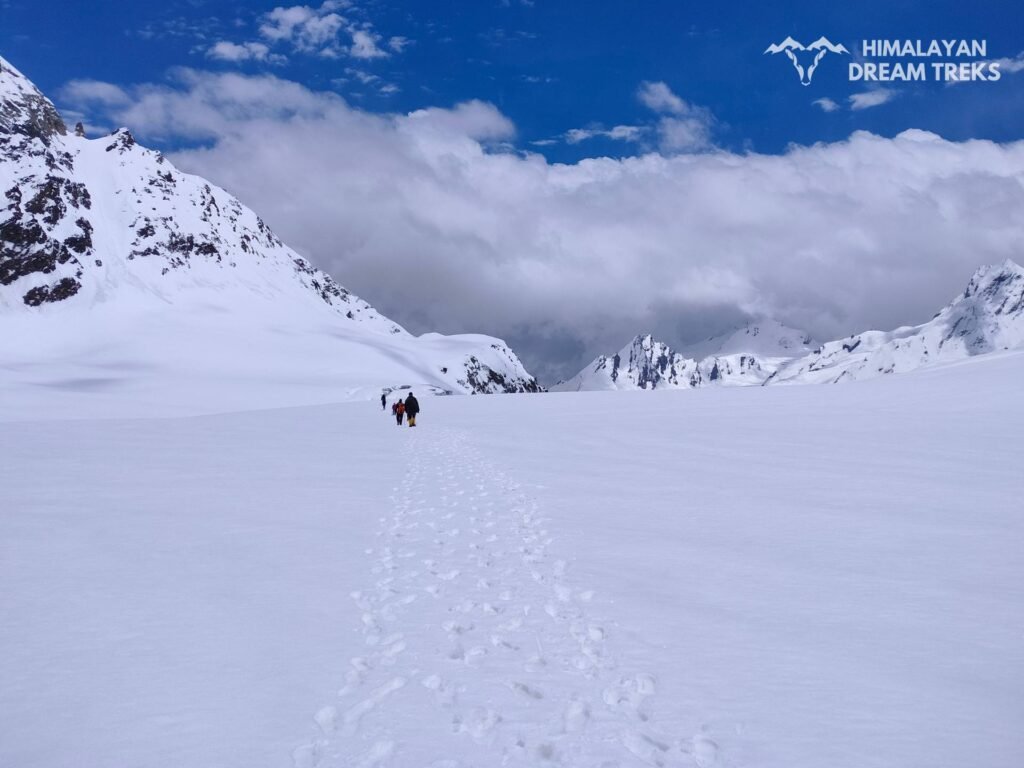
Rudugaira trek
The trek to Rudugaira Peak starts from the Rudu Valley in the Gangotri National Park. Located at an elevation of 5819 m, it gives stunning views of the Gangroti group and Jogin Group of mountains. The beautiful view of Auden’s Col adds charm to its landscape.
The trek is easy and is suitable for beginners and seasoned hikers alike. The total journey to Rudugaira Peak covers a distance of around 30 km to and fro, which can take about 5-6 days.
Glacier and River System of Gangotri National Park
Gangotri Glacier is one of the largest glaciers of the Indian Himalayas, located at the crux of Gangotri National Park. Extending approximately 30 km in length and 4 km in width, it is the primary source of the Bhagirathi River, a major tributary of the Ganga. Millions of years of geological activity and climatic conditions, with the accumulation of snow and ice have formed the Gangotri Glacier. Its landscape features crevasses, seracs, and ice falls. Its vibrant views of blue ice attract trekkers and adventurers from around the globe.
The glacial meltwater from the Gangotri Glacier flows into various river systems, like the Bhagirathi River. The glacier has three main tributaries, Raktvarn, Chaturangi (including Kalindi Bamak) and Kirti. Four other glaciers, Maitri, Meru, Bhrigupanth and Manda feed the river Bhagirathi.
The protected area of Gangotri is home to several alpine glaciers:
Gangotri Glacier, Chaturangi Glacier, Rudugaira Bamak, Kedar Bamak, Raktavarna Glacier, Janak Glacier, Nilapani Bamak, Surali Bamak, Tara Bamak, Mana Bamak, Suralaya Glacier, Vasuki Glacier, Kankoteli Glacier, Swachhand Bamak, Maiandi Bamak, and more.
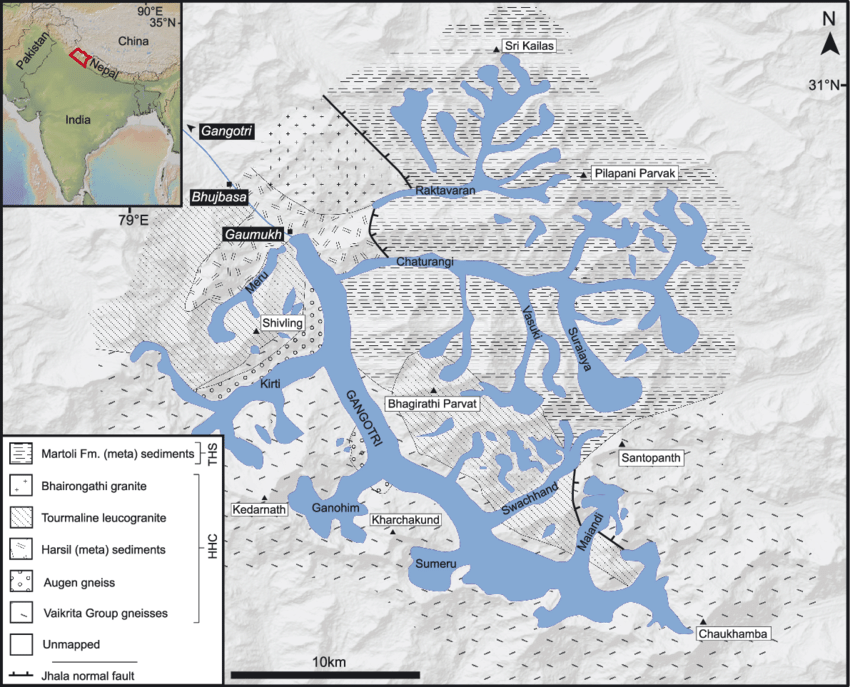
Apart from Gangotri Glacier being the main source of the Bhagirathi River, the other glaciers of the park feed some of the important tributaries, such as:
- Kedar Ganga from Kedar Tal: joins Bhagirathi at Gangotri
- Rudugaira Gad from Rudugaira Glacier: a glacial stream that forms a deep gorge at Rudra Valley
- Jad Ganga from Nelong: joins Bhagirathi at Bhaironghati
- Akash Ganga from Shivling, Tapovan
Bhujbasa Gad, Matri Gad, Chirbasa Gad, and Deo Gad are other river sources of Bhagirathi
Four other glaciers, Maitri, Meru, Bhrigupanth and Manda feed the river Bhagirathi. The glaciers of Gangotri National Park are crucial reservoirs of river water. During the summer, the glaciers melt, feeding the rivers below. This seasonal melting feeds the rivers downstream, to make water available for ecosystems and locals throughout the year.7

Prominent Peaks
The national park attracts many mountaineers and adventurers with its majestic mountain peaks towering over the landscape. Out of 63 mountain peaks, the ten prominent ones are:8
| Peak Name | Elevation (m) | Prominence (m) |
|---|---|---|
| Chaukhamba I | 7,138 | 1,596 |
| Satopanth | 7,075 | 1,058 |
| Chaukhamba II | 7,058 | 124 |
| Chaukhamba III | 6,974 | 176 |
| Kedarnath Main | 6,940 | 1,416 |
| Sri Kailas | 6,932 | 1,128 |
| Thalay Sagar | 6,904 | 1,160 |
| Bhagirathi I | 6,856 | 672 |
| Chaukhamba IV | 6,854 | 155 |
| Kedarnath Dome | 6,831 | 185 |
| Bhrigupanth | 6,772 | 976 |
| Kharchakund | 6,623 | 832 |
| Shivling | 6,543 | 881 |
| Jogin I | 6,465 | 843 |
Conservation Efforts in Gangotri National Park
The sensitive ecosystem of the park is prone to degradation and exploitation by the tourism industry. It was marked as a protected area to conserve its endangered species and the cultural aspects of the locals in the area. The State Forest Department of Uttarakhand administers the Gangotri National Park. It runs various conservation programs and campaigns such as:9 10
- Wildlife Conservation Programs: These programs target endangered species like snow leopards and Himalayan blue sheep by creating goal-oriented projects for their prevention.
- Snow Leopard Conservation Center: India’s first SLCC is proposed to be built in the Gangotri National Park. This project will specifically target the habitats of the big cats in the area.
- Habitats Restoration Programs: Promotes sustainable tourism to preserve the natural habitats of forest dwellers and prevent climate change
- Community Engagement Campaigns: These specific initiatives are designed to control the human-wildlife conflict in the protected area. The campaigns motivate the local communities and tourists to practice responsible eco-tourism.
- Large Landscape Conservation Projects: One of the LLCPs in the Gangotri region is the SECURE initiative that focuses on the conservation of the upper ranges of the Himalayan ecosystem. It focuses on wildlife conservation with the help of community efforts.

Wrapping Up
The Gangotri National Park, combined with the sanctity of the Gangotri Dham, is the perfect destination for spirituality and adventure seekers. From exciting treks to rich flora and fauna, the area truly manifests Uttarakhand’s best-preserved treasure. The best time to visit the park is from May to October, spring being the best season for nature lovers. While visiting this hidden gem of nature, follow responsible tourist practices and respect the locals. You can plan your trip to the Gangotri National Park by acquiring the necessary permits to have a one-of-a-kind experience in the heart of nature.
- GNP WII (https://wii.gov.in/nmcg/protected-areas-along-ganga/gangotri-national-park) ↩︎
- https://datazone.birdlife.org/site/factsheet/gangotri-national-park-iba-india/text ↩︎
- https://www.vpuniyal.com/images/gangotri_np_report.pdf ↩︎
- https://datazone.birdlife.org/site/factsheet/18454 ↩︎
- https://vpuniyal.com/images/envis_manish_vpupiyal.pdf ↩︎
- https://snowscapes.blogspot.com/2013/08/in-valley-of-jadhs-june-2013-part-22.html ↩︎
- https://www.researchgate.net/publication/351626434_Morphological_characteristics_of_Gangotri_glacier_area_Uttarakhand_using_GIS_Remote_Sensing_techniques ↩︎
- https://peakvisor.com/park/gangotri-national-park.html#ecology ↩︎
- https://indiabioscience.org/news/2020/protecting-the-unprotected-in-the-bhagirathi-basin ↩︎
- https://www.researchgate.net/publication/329033605_Cultural_Significance_and_Current_Conservation_Practices_of_the_Ganga’s_Ecosystem_and_Environment ↩︎

Leave a Comment